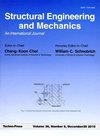采用Chebyshev-Ritz-Bolotin方法对3-未知梯度多孔纳米板的动态稳定性进行了数值模拟和计算机模拟
IF 3
4区 工程技术
Q2 ENGINEERING, CIVIL
引用次数: 1
摘要
采用Chebyshev-Ritz-Bolotin方法对梯度多孔纳米板的动态稳定性进行了数值模拟和计算机模拟。根据非局部弹性和捕获中性表面位置的3-未知板模型,制备了纳米板。假定材料的所有性能都取决于孔隙率因子,孔隙率因子决定了孔隙的数量或体积。在温度和湿度变化的条件下,也假设了纳米板。结果表明,纳米板的稳定性边界取决于静、动载荷因素、孔隙率因素、温度变化和非局部参数。本文章由计算机程序翻译,如有差异,请以英文原文为准。
A numerical and computer simulation for dynamic stability analysis of 3-unknown graded porous nanoplates using a Chebyshev-Ritz-Bolotin method
A numerical and computer simulation for dynamic stability analysis of graded porous nanoplates has been provided using a Chebyshev-Ritz-Bolotin approach. The nanoplate has been formulated according to the nonlocal elasticity and a 3-unkown plate model capturing neutral surface location. All of material properties are assumed to be dependent of porosity factor which determines the amount or volume of pores. The nano-size plate has also been assumed to be under temperature and moisture variation. It will be shown that stability boundaries of the nanoplate are dependent on static and dynamical load factors, porosity factor, temperature variation and nonlocal parameter.
求助全文
通过发布文献求助,成功后即可免费获取论文全文。
去求助
来源期刊

Structural Engineering and Mechanics
工程技术-工程:机械
CiteScore
3.80
自引率
18.20%
发文量
0
审稿时长
11 months
期刊介绍:
The STRUCTURAL ENGINEERING AND MECHANICS, An International Journal, aims at: providing a major publication channel for structural engineering, wider distribution at more affordable subscription rates; faster reviewing and publication for manuscripts submitted; and a broad scope for wider participation.
The main subject of the Journal is structural engineering concerned with aspects of mechanics. Areas covered by the Journal include:
- Structural Mechanics
- Design of Civil, Building and Mechanical Structures
- Structural Optimization and Controls
- Structural Safety and Reliability
- New Structural Materials and Applications
- Effects of Wind, Earthquake and Wave Loadings on Structures
- Fluid-Structure and Soil-Structure Interactions
- AI Application and Expert Systems in Structural Engineering. Submission of papers from practicing engineers is particularly encouraged.
 求助内容:
求助内容: 应助结果提醒方式:
应助结果提醒方式:


